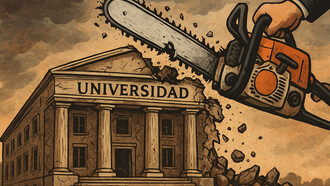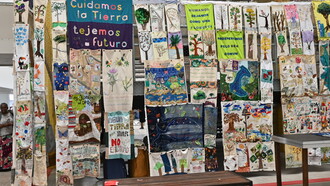At the UN Biodiversity Conference, a resolution was passed on population and land area. It is difficult to say whether it will do more harm to developed or developing countries.1 Not only is 30% of the world's total area to be protected by 2030, but also 30% of the area of "degraded ecosystems" are to be safeguarded in the same way.2
A "degraded ecosystem" may be defined in baffling ways in this document. For example, it may be a beautiful, useful area of farmland where there used to be a swamp full of disease-causing mosquitoes, and "protecting" this area means nothing other than "renaturalising" it, in our example, by putting it under water again and making it virtually useless for the people in the surrounding area. Here in Germany, for example, this affects large areas in Lower Saxony.3
Back in 2020, the EU adopted the Biodiversity Strategy, which envisages precisely this 30% protected land area by 2030, with the additional condition that one third of it must be strictly protected. In June 2022, the EU Commission had already drafted legislation to enshrine this strategy, the "Nature Restoration Law". This also contains the 30% target for "degraded ecosystems".4 This means that while most of the 188 countries that signed the UN agreement have yet to implement it, the EU is just around the corner.
This will manifest itself most clearly in food prices. Less arable land means less supply and higher prices, which will be exacerbated by the EU's separate target of allowing only organic farming on 25% of the agricultural land remaining after swamping and similar "renaturalisation", also by 2030.5 Food accounts for a large proportion of expenditure, especially for lower-income groups, and this has already been exacerbated by rampant inflation.
Taxes will also have to be increased in order to achieve the desired protection goals. Germany still has a constitution that protects property. This means that the state can only achieve conservation goals on private property through "incentives," meaning it has to pay landowners money to farm it only in certain ways or, even more expensively, not at all.
However, it is almost impossible to estimate the cost to the taxpayer, as nobody knows what percentage of land is actually owned by the state. The last comprehensive survey took place in West Germany in 1974, when just under a third of the land was owned by the state, divided between the federal government, federal states, and local authorities.6
However, this of course also includes settlement and transport areas, which are probably not taken into account in these percentage targets. The federal government has therefore agreed to this target without even having the data to be able to estimate the costs. But perhaps they also went into it with a "whatever the cost" attitude. After all, at least the target is guaranteed to affect many privately owned areas, as the majority of reclaimed agricultural land is in private hands.
Although it is irresponsible on the part of the federal government not to really know how much of the lofty conservation goals the state can achieve on its own land and how much it has to pay privately for, we must not pretend that the protection of state land has no consequences. If, for example, less wood is produced in the state forest (the data situation is better here, 29% of the German forest area is owned by the federal states and 4% by the federal government7) not only is the income from sales lost for the state, which will be offset by more taxes, but also added value and jobs in the industries that rely on the raw material.
Even if the entire German state forest were to be given strict protection status, it only accounts for around 9% of the country's land area, a far cry from the 30%. What is already putting a strain on state finances, and therefore taxpayers, is that the federal government has abandoned the elimination of failing land ownership policies in East Germany, left over from the Soviet era.8
The land expropriated by the SED government was transferred to federal ownership upon reunification, and since 1992, the BVVG has been entrusted with its reprivatisation. This company generated a surplus of 251 million euros in 2021.
At the end of 2022, the federal government stopped this project, which is worthy of a liberal democracy, and decided to keep the majority of the remaining 91,000 hectares in order to lease them to organic farmers or dedicate them to nature conservation in line with the plans discussed here. This will be very expensive but will hardly make any difference in relation to the gigantic percentage targets, as it only concerns around 0.25% of Germany's land.
The impact on developing countries will also be detrimental, but in a different way. While in developed countries such as Germany, land that was made economically viable by our ancestors and thus still contributes to our prosperity today is being impaired, this process is being nipped in the bud in developing countries on at least 30% of their land, which means large sections of the population will never be able to achieve western levels of prosperity. This is because it is not just about potential agricultural land but also about mining, infrastructure, industrial areas, and, in short, industrialisation.
Brazil is a very good example. Former and current president Lula da Silva, who was convicted of corruption in 2017,9 was given advance praise by the same media as soon as he took office, as he prefers to take Western money, including quite a lot of German taxpayers' money,10 for doing very little in the rainforest instead of opening up economic opportunities for his population on the vast expanse of land.
All this is justified on the grounds of biodiversity, but large-scale state intervention is not the only way to achieve this goal, although it is certainly the most harmful for people. Cultural landscapes, which we have almost everywhere in the EU, can be very species-rich due to their structural richness; the lively alternation between forests and meadows, fields and gardens, roadsides and embankments, buildings, fallow land, pits and slag heaps, even more species-rich than wilderness.
It is difficult to say where the rejection of such landscapes comes from, which is expressed in an untenable equation of biodiversity with the absence of cultivation and thus the presence of human poverty. Is it dialectics that seeks to synthesise the thesis of cultivated land with the antithesis of wilderness? Is it romanticism that propagates love for the unattainable, in this case nature untouched by human hands, a love that can only be fulfilled after death, in this case the death of the economy?
Whatever the combination of these misconceptions may be, politicians like to use them for votes, journalists like to use them for articles, and environmental NGOs like to use them for power and money. After all, it is representatives of the international environmental lobby who will end up sitting in authorities, universities, and foundations to implement, monitor, and research these area targets. And to be well paid for it, from the taxes of many people around the world who increasingly have to ask themselves how they are supposed to pay for their food.
This article was written by Torben Halbe. Torben is a fellow with Young Voices Europe and a German writer and activist. He is the author of The True Life of Trees and Freedom Without Free Will.
References
1 COP15 ends with landmark biodiversity agreement.
2 Drive to protect world’s wetlands gains momentum.
3 National peatland protection strategy.
4 Biodiversity strategy for 2030.
5 Action plan for organic production in the EU.
6 Who owns Germany?
7 Forest in Germany.
8 The federal government wants to largely stop the sale of agricultural land in the east.
9 Brazil's ex-President Lula convicted of corruption.
10 Berlin: 35 million for Amazon protection fund.















